Unstable perovskites to turn into LEDs emitting blue light
- A scientific group from UC Berkeley (USA) has developed a blue-emitting LED from halide perovskites, the cheapness and ease of making of which make them very attractive for electronic applications.

The American scientists affirm that chemical, humid and temp influence causes structural changes in a halide perovskite’s crystalline lattice. Suddenly, the researchers consider this property promising rather than limiting. Such instability makes perovskite a novel semiconductor easily configurable according to the environmental conditions. The materials can behave as sensors and photoconductors, quite sensitive to chemicals and illumination.
After the discovery of halide perovskite’s photovoltaic characteristics, high-potential for solar industry, the easy-to-produce and affordable material has been thoroughly studied. Until now, only LEDs emitting green or red light have been made of perovskites. As for LEDs emitting blue light, they have failed to demonstrate stability, as their colour tends to change for long red wavelength over time. The researchers explain this by the exclusive structure of perovskite lattice.
The research team has applied an innovative tech to bromine, cesium and lead contained in the perovskite structure in order to create a blue-emitting crystal, after which exposed it to X-ray bombarding. The experiment has shown that when the temp rises from normal 300K up to about 450K, the light produced by a diode takes a greenish tint.
Making blue diodes from perovskite has been a challenging process, since when crystals are being grown in the form of thin films, it results in mixing crystalline structures emitting various wavelengths. To eliminate this effect, the Californian research group has grown a layered perovskite crystal. Anyway, under high temp, the created diode changes its light colour. However, the developers consider it to be a promising quality. A couple of years ago, a window was created that changed its transparency becoming dark under sunlight and see-through in the darkness, and producing PV energy.
Also read

